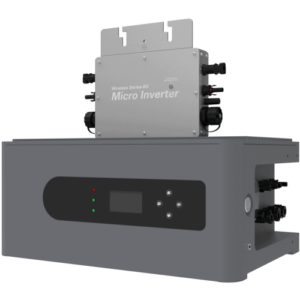目录
ToggleSingle phase inverters are essential for converting direct current (DC) into alternating current (AC) for use in homes, small businesses, and other electrical systems. Whether you want to manage backup power, power home appliances, or support a small solar setup, knowing what single phase inverters are can help you choose the right one. Let us examine single phase inverters, their operation, and how to select the most appropriate one for your needs.
What is a Single-Phase Inverter?
A single-phase inverter is an apparatus that transforms DC power—usually from solar panels or batteries—into AC power appropriate for single-phase applications. Unlike three-phase inverters, which are frequently utilized in high-power and industrial applications, single phase inverters are perfect for mild commercial and household use. These inverters are found in smaller systems, providing AC power at a conventional voltage (110V or 230V, depending on your region) and frequency (50 Hz or 60 Hz).

How Single Phase Inverters Work
Single phase inverters use power electronics to convert DC input into AC output. They produce an AC waveform by rapidly switching the polarity of a DC input. Many single phase inverters use pulse width modulation (PWM) to create a clean sine wave that is more in line with the grid’s power supply and compatible with most electrical appliances.
Single phase inverters are essential for ensuring that the electricity produced by renewable sources, such as solar panels, is suitable for your residence or place of business. They are, therefore, essential to small-scale renewable energy systems, enabling you to maximize the benefits of sustainable, clean energy.
Types of Single Phase Inverters
Single phase inverters come in various forms, each with special characteristics that meet the needs of particular uses. Below is a summary of the most prevalent kinds:
Pure Sine Wave Inverters
Pure Sine Wave Inverters are perfect for sensitive electronics and most home appliances. They generate a smooth, high-quality sine wave that nearly mimics grid power. A pure sine wave inverter is ideal if you require clean, dependable electricity.
Modified Sine Wave Inverters:
These are less expensive and appropriate for simple appliances like fans and lights, but they might not be compatible with delicate equipment. The harsher wave of modified sine wave inverters can result in reduced efficiency and possible interference, which some circuits may find challenging to handle.
Grid-Tied Inverters:
These inverters synchronize with the main power grid and enable you to feed surplus energy from solar panels and other sources back into the grid. Grid-tied inverters are frequently necessary for solar systems that sell excess electricity to the utility company.
Applications of Single Phase Inverters
Because of its versatility, single phase inverters can be employed in various situations. Here’s an example where you could use one:
Residential Power Backup: During grid disruptions, single phase inverters, which transform DC power stored in batteries into AC power, are common backup power options. They can continue operating necessary appliances and gadgets until the electricity is restored.
Solar electricity Systems: When used in conjunction with solar panels, single phase inverters transform the DC electricity produced by your array into AC power that is grid-compatible and usable by household appliances.
Off-Grid Applications: In remote locations without access to the main power grid, single phase inverters supply AC power for various applications. They are necessary for small agricultural settings, cottages, and off-grid houses.
0